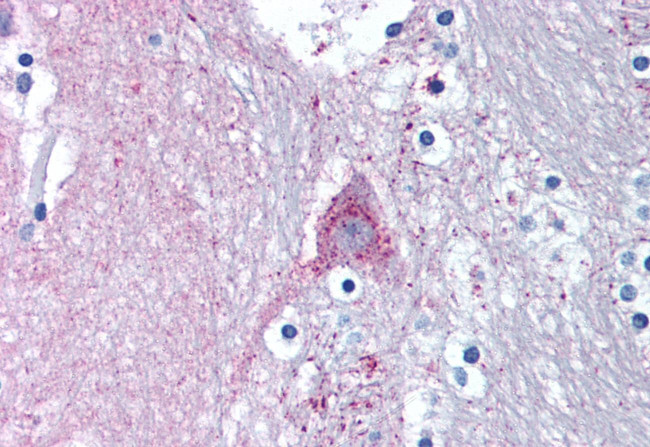Search Thermo Fisher Scientific
Product Details
PA5-32914
Species Reactivity
Host/Isotype
Class
Type
Immunogen
Conjugate
Form
Concentration
Purification
Storage buffer
Contains
Storage conditions
Shipping conditions
RRID
Product Specific Information
Percent identity with other species by BLAST analysis: Human, Gibbon, Monkey, Marmoset, Dog, Bat, Bovine, Panda, Rabbit, Opossum (100%); Elephant, Horse, Lizard (94%); Rat, Turkey, Chicken, Platypus (89%).
For IHC(P), use heat induced antigen retrieval in pH 6.0 citrate buffer. After incubation with the primary antibody, slides were incubated with biotinylated secondary antibody, followed by alkaline phosphatase-streptavidin and chromogen.
Target Information
MARK1 (MARK) is a serine/threonine kinase which is involved in cytoskeletal organization and biogenesis. Involved in cell polarity by phosphorylating the microtubule-associated proteins MAP2, MAP4 and MAPT/TAU at KXGS motifs, causing detachment from microtubules, and their disassembly. MARK1 is involved in the regulation of neuronal migration through its dual activities in regulating cellular polarity and microtubule dynamics, possibly by phosphorylating and regulating DCX. Also acts as a positive regulator of the Wnt signaling pathway, probably by mediating phosphorylation of dishevelled proteins (DVL1, DVL2 and/or DVL3).
For Research Use Only. Not for use in diagnostic procedures. Not for resale without express authorization.
References (0)
Bioinformatics
Protein Aliases: MAP/microtubule affinity-regulating kinase 1; MARK1; Par-1c; PAR1 homolog c; Serine/threonine-protein kinase MARK1
Gene Aliases: KIAA1477; MARK; MARK1; Par-1c; Par1c
UniProt ID: (Human) Q9P0L2
Entrez Gene ID: (Human) 4139, (Dog) 478965, (Bovine) 539563, (Rabbit) 100339168

Performance Guarantee
If an Invitrogen™ antibody doesn't perform as described on our website or datasheet,we'll replace the product at no cost to you, or provide you with a credit for a future purchase.*
Learn more
We're here to help
Get expert recommendations for common problems or connect directly with an on staff expert for technical assistance related to applications, equipment and general product use.
Contact tech support

